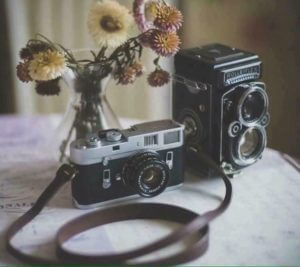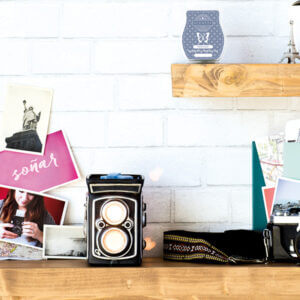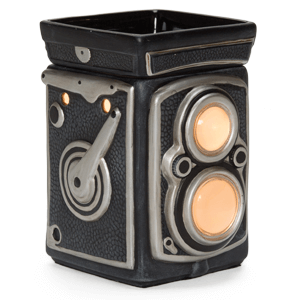Scentsy Warmer of the Month for August
The Scentsy Special Warmer for August is Still Frame, the perfect warmer for the photographer in your life.
Modeled after a vintage twin-lens reflex camera, Still Frame will delight anyone who loves photography, travel or recapturing the beauty of a bygone era. Picture perfect!
Purchase the August Scentsy Warmer of the Month Online
Twin Lens Reflex Camera
I have always loved anything vintage and the stories that go along with the items. My father has always been into photography. Growing up I remember he had converted a closet into a dark room where he would develop his own film. When the camera Scentsy warmer was announced, I ask him about this cameras. Here is his quick history of the twin lens reflex camera.
This is modeled after what was known as twin lens reflex cameras. One lens, the top one, directed light to a mirror that sent the light up to a focusing screen. The bottom lens sent light to the film. This design avoided the complexity associated with a single lens reflex (SLR) – and now digital single lens reflex (DSLR). The “reflex” term refers to what the top lens does. Rollei made the best know and expensive Rolleiflex. I had one, in New Orleans, made by Yashica. I loved that camera and may still have it somewhere. Naturally, it was called the Yashica Mat. These types of cameras used 120 sized film which was larger than the 26mm x 35mm film used by SLR cameras (such as the Nikon F) – called 35mm cameras because of the long dimension of the film. The 26 x 35 mm film was used because that was what movies used and therefore was readily available. The 120 size, 6 x 6 cm, produced a much better negative but was not as convenient. 35mm film could take 36 exposures and was spooled inside a light-tight cartridge that was easy to use and process. The 120 film was a roll of film with a paper backing and was limited to about 12 images. But what really did in the twin lens reflex was its inability to easily change lenses (and thereby change focal length). Rollei made clip on lens extenders but they never matched Nikon’s ability to produce very high quality lenses (Nikon’s lenses from the 50’s are still in use) in every configuration anyone would ever need. One other note; because you were looking and focusing through the top lens on the TLR cameras and taking the actual exposure through the bottom lens, there was a parallax offset due to the lenses not being on the same axis.. This usually wasn’t a big deal, but the closer you got to the subject, the greater the shift and there was a good chance that part of the image you were after would be cut off.
Twin-lens reflex cameras have been around since the 1870s, initially developed to make it easier, and faster, to focus a camera between shots instead of swapping the ground glass screen for the plate, reducing the time required for taking a picture.[1] This sort of approach was still used as late as the 1960s, as the monstrous Koni-Omegaflex[2] testifies.
The Rolleiflex arrived in 1929. The first Rolleiflexes lacked a crank to advance the film inside the camera until 1931. The Rolleiflex was widely imitated and copied and most mass-market twin-lens-reflex cameras owe much to its design. It is said that Reinhold Heidecke had the inspiration for the Rollei twin-lens-reflex whilst undertaking photography of enemy lines from the German trenches in 1916, when a periscopic approach to focusing and taking photos radically reduced the risk to the photographer from sniper fire.[4]
In 1940, following the war, American companies began to produced a number of twin-lens-reflex cameras. The Argus Argoflex E in 1940 came first, followed by the Ciro-Flex A. Graflex, Craftex, and Royce also produced TLRs.
The Standard 620 from 1932 is easy to spot for the cross on its finder lid, while the Automat from 1937 continued to be produced, with various improvements, until 1956.New Rolleiflex F series cameras are still being produced today! They have even re-introduced the Tele and Wide Angle cameras.
The Rolleiflex has a long list of inspiring and master photographers who considered this camera one of their favorites. Some famous Rolleiflex camera users include Richard Avedon, Robert Doisneau, Diane Arbus, Vivian Maier, Irving Penn, Imogen Cunningham, and Helmut Newton.
References: History from Wikipedia, Seawood, Photography Life and Collector’s Weekly





